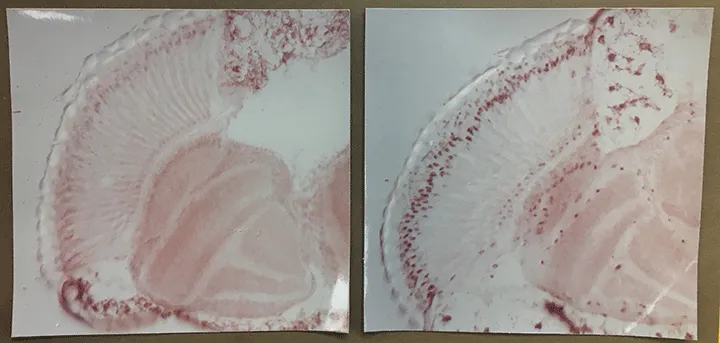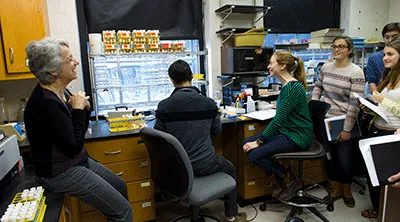Neurobiologist Kathy Siwicki's Research Cited by Nobel Prize Committee

These images show the inside of fruit fly brains at two different times of day. On the right, high levels of PER protein are shown concentrated in many cell nuclei (small, dark brown spots) in the middle of the night; on the left, very little PER (barely visible brown spots) is shown in the middle of the day.
What was once a “cool biological puzzle” has now been recognized by the Nobel Prize Committee.
Howard A. Schneiderman Professor of Biology Kathy Siwicki’s article, “Antibodies to the period gene product of Drosophila reveal diverse tissue distribution and rhythmic changes in the visual system,” published in 1988, was cited by the Nobel committee as a key publication in awarding the 2017 Nobel Prize in Physiology or Medicine to Jeffrey Hall, Michael Rosbach, and Michael Young.
Siwicki conducted the research when she was a postdoctoral fellow at Brandeis University, where she worked in Hall’s lab. There she studied the circadian rhythms of fruit flies, and though she didn’t know it at the time, she was laying the foundation for understanding the mammalian circadian clock.

Howard A. Schneiderman Professor of Biology Kathy Siwicki in her lab with students.
Siwicki’s key finding: that levels of PER, the protein encoded by period, changed throughout the day. The finding had much broader implications than understanding fruit flies.
“In the 1980s we didn’t know how similar all animal genomes would be to each other,” she explains. “We were learning a lot about human biology even though we weren’t necessarily aiming to learn about human biology.”
Siwicki heard the Nobel Prize announcement on the radio at home, but it wasn’t until she was sitting in the Bio 1 lecture later that day that she learned her paper had been cited; Assistant Professor of Biology Dawn Carone shared the news.
“I saw that my paper had been cited as one of the key publications at the same time as my students saw it," she says. "It’s a wonder that I sat still in my seat.”
Siwicki describes the whole experience as humbling and really cool. “To have work that you were part of to be recognized at this astronomically impossible level is way more than I ever expected, and certainly not something we expected when we started doing this.”
“It just goes to show just doing basic science," she adds, "asking basic biological questions about nature, and following your curiosity, which is what scientists love to do, leads to important findings that have much broader significance and implications and leads to better understanding and insights about our own biology.”



